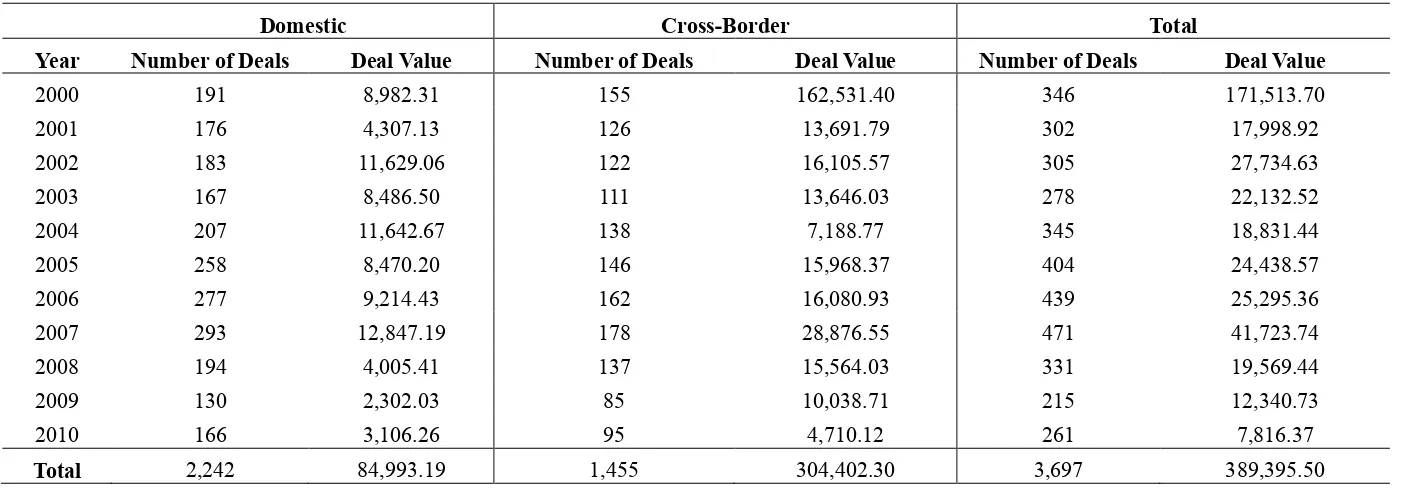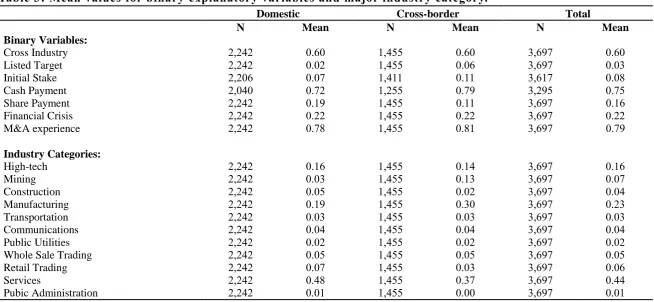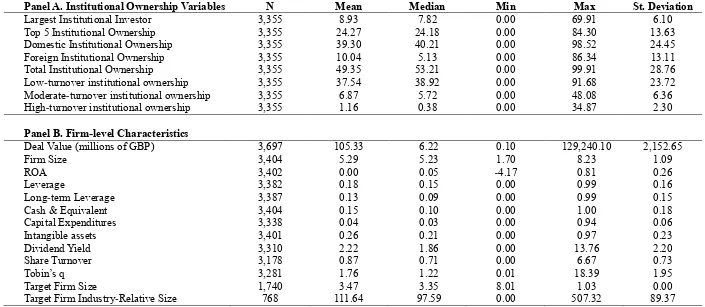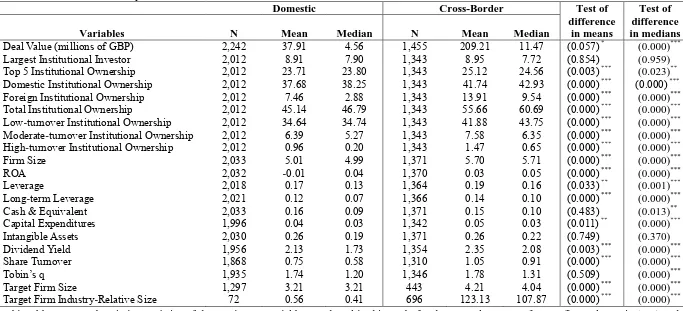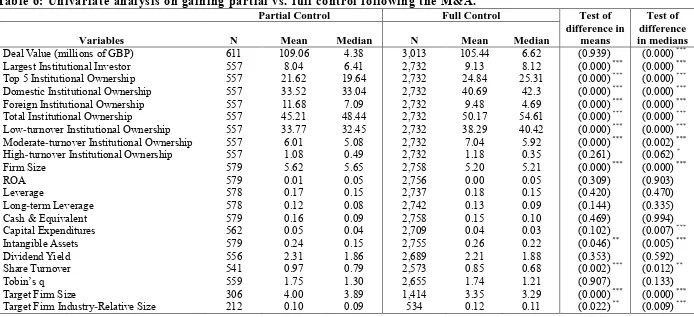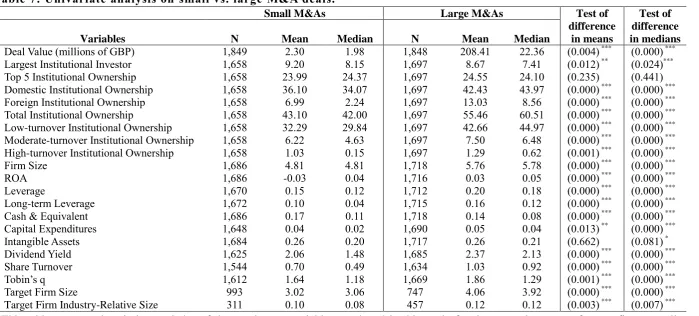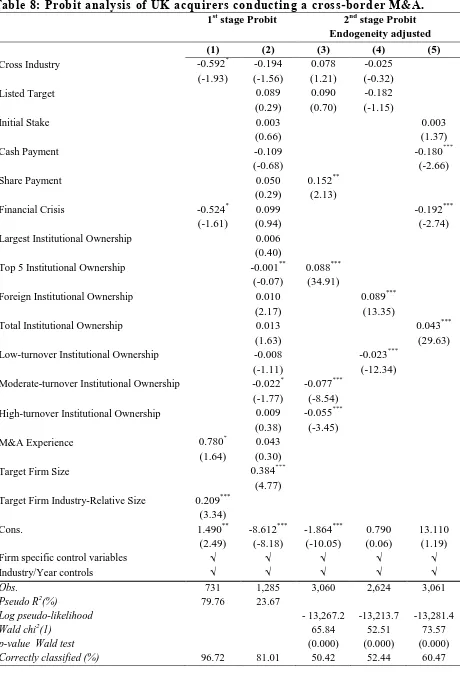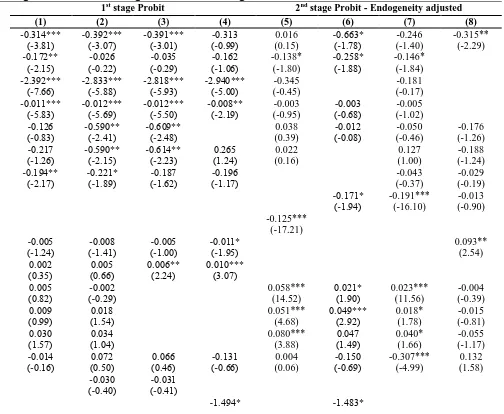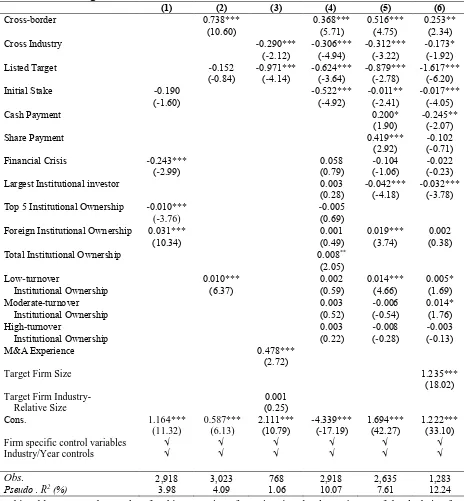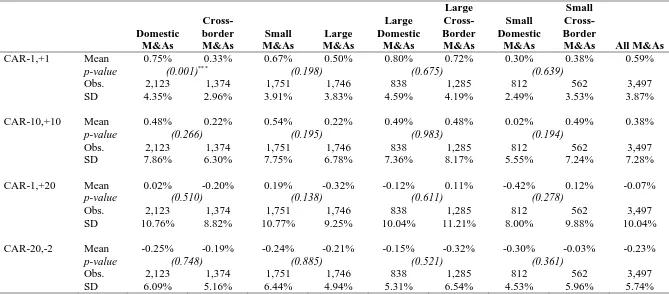1
The impact of institutional investors on mergers &
acquisitions in the United Kingdom
Dimitris Andriosopoulos a Shuai Yang b,*
Abstract
In this paper we investigate the impact of institutional ownership on UK mergers and acquisitions. We employ a comprehensive sample of M&As conducted by UK acquirers from 2000 to 2010, thus including a full cycle of peak and trough in M&A waves. We find that institutional investors increase the likelihood of an M&A to be a large, cross-border deal, opting for full control. Moreover, institutional ownership concentration and foreign institutional ownership increase the likelihood of cross-border M&As. In addition, we assess the influence of institutional shareholders’ investment horizon and find that while investment horizon have a negative influence in encouraging cross-border M&As, the presence of long-term investors encourages larger M&As. Finally, even after controlling for the 2007-08 financial crisis the market reacts negatively to the announcement of cross-border M&As.
Keywords: institutional investors, mergers and acquisitions, cross-border, investment horizon, endogeneity, financial crisis.
JEL classifications: G30, G32, G34
a Strathclyde University Business School, Department of Accounting and Finance, 100 Cathedral street, Glasgow, G4 0LN,United Kingdom
b,* Corresponding author: China Academy of Corporate Governance, Business School, Nankai University, Tianjin, China. Tel : +86-22-23498746. E-mail:
nkyangs@nankai.edu.cn
2
1. Introduction
The decision to engage in mergers and acquisitions (M&As) can significantly affect
shareholder value (Gaspar et al., 2005). A number of studies identify the significant
influence that institutional investors have on firms’ decision making, and particularly on
the US M&As (Stulz et al., 1990; Ambrose and Megginson, 1992; Chen et al., 2007;
Ferreira et al., 2010). Moreover, the holdings of institutional investors have been steadily
increasing for the last few decades resulting in large shares being held by institutional
investors in the US market (Derrien et al., 2014). In this study we examine the impact of
institutional investors in the UK takeover market from 2000 to 2010.
Since 1986, UK firms have the flexibility to conduct a placing, which is comparable
to the commitment offering of US firms. Therefore, UK firms can signal their quality via
a seasoned equity offering which increases the share ownership dispersion (Slovin et al.,
2000). The control of the equity markets by institutional investors has grown rapidly
since the 1990s in both the US and the UK (Aguilera et al., 2006). Currently,
approximately 50% of the UK equity market is controlled by institutional investors
according to the Office of National Statistics. However, managers in UK firms do not
have the same freedom as their US counterparts as institutional investors are able to exert
greater influence and become actively involved in monitoring firms’ activities (Short and
Keasey, 1999). Meanwhile, UK institutional investors exhibit a significantly lower share
turnover rate compared to the US market (Black and Coffee, 1994; Aguilera et al., 2006)
3 The size and type of shareholders can have a significant impact on firm strategy and
financial performance (Thomsen and Pedersen, 2000). Moreover, institutional investors
significantly affect executive compensation (Hartzell and Starks, 2003). However,
different shareholder groups may not have aligned interests in the firm’s developing and
investment strategies, due to increased risks and organizational complexity (Tihanyi et
al., 2003). Hoskisson et al., (2002) find that different types of institutional investors have
heterogeneous preferences for corporate innovation that affect corporate governance and
strategy.
Since institutional investors can influence corporate decisions by making their
preferences known through their stock holdings and respective trading, firms adjust their
strategic investment proposals to cater to their institutional shareholders (Hartzell and
Starks, 2003; Tihanyi et al., 2003). Fama and Jensen (1983) and Walsh and Seward
(1990) show that external governance mechanisms play an important role in curbing
managerial opportunism. Moreover, institutional investors provide effective external
monitoring of firm management (Bushee, 1998; Almazan et al., 2005; Chen et al., 2007).
Although monitoring can be costly, a large shareholder can bear the monitoring costs as
the potential returns gained from effective monitoring can be greater (Gillan and Starks,
2000). In addition, a liquid stock market allows large investors to benefit from
monitoring via informed trading, leading to more monitoring and overcoming the
free-rider problem (Admati et al., 1994; Maug, 1998; Johnson and Greening, 1999).
4 and that of varying institutional investor characteristics, on the decision of UK firms to
engage in M&As. We find that when institutional investors hold larger stakes in acquirer
firms, there is a greater likelihood of the acquirers engaging in large M&As, and
increasing the likelihood of assuming full control of the target firm. However, when we
assess the impact of the five largest institutional investors, we find there is a negative
relationship with the M&A deal size. We argue that this is because the largest
institutional investors will be averse to engaging in large M&As since it requires a
greater portion of the acquirer’s resources to be committed on the M&A. In addition,
large M&As can potentially distort the existing corporate governance dynamics and their
existing shareholdings, and the respective influence that the largest institutional investors
exert on the acquiring firm.
Investing in closely held firms can better protect investors when there are difficulties
of transferring the home country’s strong legal protection to the host country (Burkart
and Panunzi, 2006; Weitzel and Berns, 2006; Lskavyan and Spatareanu, 2011). We
investigate whether institutional ownership concentration can be complemented with
investor protection in cross-border M&As. Our results show that UK firms are typically
averse to assuming full control of foreign firms. However, when UK acquirers decide to
engage in cross-border M&As, they opt for full control of the foreign target firms which
are larger in size and relative to their respective industry. This suggests that when UK
acquirers decide to engage in cross-border M&As, they acquire larger firms thus
cross-5 border M&As tend to be larger in deal size as opposed to domestic M&As.
Domestic investors can have a significant edge in stock trading (Kang and Stulz,
1997; Choe et al., 1999) and enjoy informational advantages (Dvorak, 2005) over foreign
investors. However, Chen et al. (2009) find that foreign investors are more sophisticated
in processing information than domestic investors, in line with Seasholes (2004) who
finds that foreign investors’ performance is better compared to domestic investors.
Moreover, foreign institutional investors can help improve firm performance and deduct
capital expenditures, which play a special role in corporate governance (Gillan and Stark,
2003; Ferreira and Matos, 2008). We assess whether investor-specific characteristics
such as institutional investor horizon and country of origin (foreign vs. domestic)
influence acquirers’ decision to engage in M&As. We find that the presence of foreign
institutional investors entices UK firms to acquire foreign targets. In addition, a higher
concentration of foreign institutional investors increases the likelihood of the acquirer
assuming full control and to M&As with larger deal values. This is consistent with
Ferreira et al. (2010) who find that large and foreign institutional ownership increases the
likelihood of a cross-border M&A.
The results also show that across all three categories of institutional investors’
horizon (i.e. short-term; medium-term, and long-term) there is a negative relationship
with the likelihood of a cross-border M&A. However, when acquirers engage in an
M&A, regardless of investment horizon, there is a greater likelihood of acquirers
6 concentration of longer- and medium-horizon institutional investors increases the
likelihood of acquirers assuming full control of the target firms. This suggests that
institutional investors with medium- and long-term investment horizons are more
actively involved in a firm’s decision making and want to avoid a reduction in the value
of their investments. After controlling for firm-specific and deal-specific characteristics,
we find that the short-term market reaction to the M&A announcement is not driven by
the investment horizon of institutional investors.
M&As are clustered due to stock market valuations (Shleifer and Vishny, 2003) and
they occur in waves due to economic conditions at the firm level (Rhodes-Kropf and
Viswanathan, 2004; Harford, 2005) and the industry level (Harford, 2005). Our sample
period includes a full M&A cycle, starting from the aftermath of the dot-com bubble
when low credit prevailed and encouraged M&As, to the 2007-08 financial crisis when
liquidity dried and uncertainty increased, while paving the way for bargain M&As or
diversifying the inherent risk via cross-border M&As. Our results are robust as we
account for: the 2007-08 financial crisis as an exogenous shock; time effects; varying
economic conditions; and potential endogeneity bias as active and large stock markets
are likely to attract large and/or foreign institutional investors.
The rest of the paper is structured as follows. Section 2 discusses the literature and
defines the hypotheses. Section 3 presents the data and descriptive statistics. Section 4
7
2. Theoretical Background and Hypotheses Development
2.1 Foreign institutional ownership
It is argued that domestic investors are better informed which allows them to have a
significant advantage in stock trading over foreign investors (Kang and Stulz, 1997;
Choe et al., 2005). Similarly, Dvorak (2005) finds that domestic investors have
informational advantages over foreign investors. In contrast, Froot and Ramadorai
(2008) find a positive relationship of cross-border flow shocks to price and net asset
value (NAV) returns, suggesting that foreign investors display informational advantages
over domestic investors. This is in line with Seasholes (2004) who finds that foreign
investors perform significantly better compared to domestic investors when trading in
shares of large firms in emerging markets. Chen et al. (2009) find that when foreign and
domestic investors have access to the same information, it is the foreign investors’
sophistication and better information processing ability that allows them to earn better
returns. Croci et al. (2012) and Fernandes et al. (2013) find that foreign institutional
investors have a significant impact on CEO compensation, suggesting that foreign
institutional investors can affect firm policy and decision making.
Cultural distance and asymmetric information are significant determinants of
cross-border M&As. Therefore cross-cross-border transactions require more skilled and experienced
acquirers (Slangen, 2006; Kang and Kim, 2010; Dikova and Rao Sahib, 2013). Foreign
8 local investors, as foreign institutional ownership is strongly and positively related to
both contemporaneous and subsequent firm performance (Grinblatt and Keloharju, 2000;
Dvorak, 2005). Huang and Shiu (2009) find that firms in Taiwan with high foreign
institutional ownership outperform those with low foreign institutional ownership.
Meanwhile, foreign institutional investors can help improve firm performance and
deduct capital expenditures (Gillan and Stark, 2003; Ferreira and Matos, 2008), reduce
cultural distances, transaction costs and information asymmetries, and contribute to
international investments (Ferreira et al., 2010).
The overwhelming majority of target firms in our sample are private firms (98% of
the domestic and 94% of the cross-border target firms are privately held) rendering it
impossible to acquire accurate data on target firms’ ownership and test directly whether
target firms’ institutional ownership impacts M&As. Nevertheless we test whether the
presence of foreign institutional ownership on bidder firms overall can have a significant
impact on the M&A decision. We expect to find a positive relationship between higher
foreign institutional ownership and the likelihood of cross-border M&As. We state our
hypothesis as follows.
Hypothesis 1: Acquiring firms with greater concentration of foreign institutional ownership have a higher probability to engage in a cross-border M&A.
Institutional investors can be categorized into sensitive and
pressure-insensitive groups based on the influence they exert on the firms they invest in (Brickly
9 pressure-insensitive investors are better suited to monitor and discipline managers and
they have a positive impact on firms’ cash-flows and returns. Almazan et al. (2005) find
that higher levels of pressure-insensitive institutional ownership are positively related to
greater control on executive compensation.
Gillan and Starks (2003) suggest that foreign institutional investors are part of the
pressure-insensitive investors as they have less business relations with the firms they
invest in. Hence, foreign institutional investors can potentially influence corporate
governance but it is unclear whether they can act as pressure-insensitive investors with
an active monitoring role. Furthermore, foreign investors provide alternative financing
resources and also share the risk of domestic stock markets (Bekaert and Harvey, 2000;
Gupta and Yuan, 2009; Li et al., 2011). Foreign capital can promote the economic growth
by lowering the cost of external capital (Bekaert and Harvey, 2000) while improving the
quality of information in local markets and thus substantially decreasing transaction costs
and risk exposure (Li et al., 2011). We argue that foreign institutional investors are active
monitors as part of pressure-insensitive investors. Our hypothesis is stated as follows.
Hypothesis 2: Foreign institutional ownership of acquiring firms has a positive relationship with the deal size of M&As.
2.2 Block institutional ownership
Large institutional investors can have a greater monitoring impact, compared to
small investors, in order to protect their sizable investment and enhance the value of their
10 However, large non-institutional investors can apply effective monitoring skills (Shleifer
and Vishny, 1986; Agrawal and Gershon, 1990; Hartzell and Starks, 2003), similar to
large institutional investors even though they may be facing their own agency problems
(Kahl and Gorton, 1999). Gillan and Starks (2003) argue that only shareholders with
large positions are likely to earn a return on their investment that is large enough to
justify the monitoring costs involved. Meanwhile, large shareholders are more willing to
focus on the long-term performance of the firms they invest in. Therefore, large
shareholders will encourage managers to focus on long-term profitability (Dharwadkar et
al., 2008). We argue that large institutional investors, captured by the holdings of the
largest investor, will be effective monitors and will have a significant impact on M&As.
The testable hypothesis is stated as follows.
Hypothesis 3: The ownership stake of the largest institutional shareholder has a significant impact on the deal size of M&As.
For cross-border investments, the home country’s strong legal protection may be
difficult to transfer to the host country. Therefore, a high level of ownership
concentration can enhance shareholder protection (Weitzel and Berns, 2006; Lskavyan
and Spatareanu, 2011). Lskavyan and Spatareanu (2011) find that while weak
shareholder protection in the host country reduces foreign direct investments, it is less
pronounced for firms that are more closely held, suggesting a substitution effect.
Blockholders can serve as effective monitors of managerial performance or facilitate
11 induces better monitoring while other small institutional investors might have fewer
incentives to engage in the costly monitoring activities (Burns et al., 2010). Clyde (1997)
finds that firms with high level institutional concentration are more likely to use
takeovers. We expect to find that a higher concentration of institutional investors will
influence acquirers’ decision to engage in M&As. Hence, we state our testable
hypothesis as follows.
Hypothesis 4: Acquiring firms with greater concentration of total institutional ownership have a higher probability to engage in a cross-border M&A.
2.3 Investment horizon of institutional shareholders
Dong and Ozkan (2008) and Bushee (1998) find that institutional investors with
long-term investment horizon are effective monitors when they are actively involved in
the firm’s decision making. Bushee (1998) argues that the presence of a large proportion
of institutional investors with high portfolio turnover and momentum trading
significantly encourages managers’ myopic investment behavior.
The portfolio turnover of institutional investors in the UK is significantly lower
compared to the US (Black and Coffee, 1994; Aguilera et al., 2006). This relative
stability and longer-term horizon may encourage more UK institutional investors to
increase their monitoring of firms and influence their respective decision making in order
to enhance firm performance or reduce strategic risk, rather than simply sell shares of
companies that are underperforming (Clark and Hebb, 2004; Aguilera et al., 2006). We
12 M&A strategies. The testable hypothesis is stated as follows.
Hypothesis 5: The investment horizon of institutional investors has a significant impact on the deal size of M&As.
3. Data and Descriptive Statistics
We identify all mergers and acquisitions reported in Bureau Van Dijk from 01:2000
to 12:2010. We select only deals where the acquirers are UK firms. The final sample is
selected by complying with the following conditions. 1) The bidder has both equity
ownership records available from Thomson Reuters and financial records at the year-end
prior to the announcement from Worldscope. 2) The transaction is completed at the end
of the sample period. 3) All financial bidder and target firms are excluded from the
sample (2-dig SIC 60-69) as in Elyasiani and Jia (2010). 4) We exclude deals with a
value less than £ 0.1 million. 5) Targets are both UK and non-UK firms, including listed,
private, and subsidiary firms. These criteria yield a final sample of 3,697 completed
M&A deals undertaken by UK public listed companies, comprising 2,242 domestic
targets (61%) and 1,455 foreign targets (39%).
Firm-level institutional ownership characteristics are obtained from Thomson
Reuters1 which compiles information contained quarterly in the 13F historical holders.
We calculate the proportion of foreign institutional ownership, domestic institutional
13 ownership as well as total institutional ownership in each firm at the year-end prior to the
deal announcement, as in Aggarwal et al. (2011) and Cornett et al. (2007). Meanwhile
we examine possible effects of concentrated institutional ownership. For measuring
institutional ownership concentration we follow Hartzell and Starks (2003) and Bhojraj
and Sengupta (2003) and employ two alternative variables: the percentage shareholdings
of the largest institutional ownership proportion; and the cumulative five largest
shareholdings held by institutional investors. Finally, for the investment horizon of
institutional owners we apply the three investment categories, namely low-turnover,
moderate-turnover and high-turnover institutional ownership as defined in Thomson
Reuters.2 All the variable descriptions are provided in Table 1.
[Insert Table 1 about here]
Table 2 presents the annual distribution of all M&A deals announced and completed
by UK listed bidder firms from 2000 to 2010 including both domestic and cross-border
deals. The total value of cross-border M&As (approximately £300 billion) is a significant
proportion of the total value of M&A deals (approx 77%) undertaken by UK bidders
2 The three main categories of institutional shareholders’ investment horizon provided in Thomson
14 between 2000 and 2010. This shows that cross-border M&As are mostly large deals
while domestic deals are more frequent but smaller in size.
[Insert Table 2 about here]
Table 3 reports the descriptive statistics for all binary variables and industry
classifications included in our tests. The figures show that firms engaging in cross-border
M&As target more listed firms in which they have larger existing shareholdings, as
opposed to domestic deals. This serves as an early indication that acquirers target
cross-border firms with comparatively lower information asymmetries, since, listed foreign
firms in which the bidders already own a stake are bound to have lower information
asymmetries. This is consistent with Cho and Padmanabhan (2005), Slangen (2006), and
Kang and Kim (2010). Moreover, the results show that the mining and services industries
are more prominent in cross-border M&As and are the dominant industries for M&As
overall.
[Insert Table 3 about here]
The descriptive statistics presented in Table 4 show that the total institutional
ownership of acquirer firms is on average 49.35%. This is consistent with Franks and
Mayer (1997) and Goergen and Renneboog (1998) who show that institutional investors
are the dominant shareholding group in the UK. The average foreign institutional
ownership is 10.04% which is similar to the 11.30% foreign institutional ownership
reported in Ferreira et al. (2010). Domestic institutional investors control on average
15 while the largest institutional investor holds on average 8.93%. Moreover, the figures
show that institutional investors have a predominantly low-turnover ratio (37.54%)
suggesting they have a longer-term investment horizon. This is in line with Black and
Coffee (1994) and Aguilera et al. (2006) who find that UK institutional investors have a
significantly low turnover ratio while indicating they may play an active role in firms’
decision making process.
[Insert Table 4 about here]
4. Empirical Evidence
4.1 Univariate analysis
We analyze the differences in the institutional ownership and firm-level
characteristics between domestic and cross-border M&As. The results, reported in Table
5, show that institutional shareholders hold statistically larger stakes in firms conducting
cross-border M&As (55.66%) compared to domestic deals (45.14%). Moreover, foreign
institutional investors have greater control (13.91%) of bidder firms targeting foreign
firms, compared to targeting domestic firms (7.46%). This suggests that the presence of
foreign institutional investors may play an active role in encouraging cross-border
M&As. The results also show that compared to domestic deals, cross-border M&As are
conducted by acquiring firms in which institutional investors with low share turnover
own greater stakes. In addition, UK acquirers conducting cross-border M&As have
16 concentration may complement shareholder protection, hence, encouraging firms to
engage in cross-border investments (Burkart and Panunzi, 2006; Weitzel and Berns,
2006; Lskavyan and Spatareanu, 2011).
The results on firm-specific characteristics show that acquirers undertaking
cross-border M&As are larger with higher leverage and share turnover rate, and deliver better
shareholder returns. This suggests that cross-border M&As involve acquirers that are
more able to alleviate potential hurdles and acquire large target firms. Finally, the results
show that foreign target firms are significantly larger than the average market
capitalization of their industry, as the average target is more than 100 times larger than
the average industry size. This indicates that foreign targets are the dominant players in
each industry in terms of size suggesting that bidders acquire not just any firm but the
largest participants in the industry, hence, aiming to capture a larger market share in the
foreign market.
[Insert Table 5 about here]
Subsequently, we partition our sample into two groups based on whether acquirers
assume partial or full control of target firms. The results presented in Table 6 show that
firms in which the five largest institutional investors own larger stakes (24.84%) and
total institutional ownership is higher (50.17%) take full control of their target firms.
Moreover, we find that the domestic institutional ownership, low-turnover institutional
ownership, and the ownership of the largest institutional investor are higher for firms
17 acquirers that assume full control of the target firms have higher liquidity (captured by
cash and equivalents) and profitability (proxied by ROA). In contrast, firms obtaining
full control have foreign investors holding smaller stakes (9.48%) as opposed to firms
acquiring partial control (11.68%)., which is contrary to Ferreira et al. (2010). Finally,
firms acquiring partial control tend to be larger and have higher share turnover rates.
[Insert Table 6 about here]
We also split our sample of firms between small and large deals based on the median
M&A deal value of the overall sample. The results reported in Table 7 show that
acquirers with greater institutional ownership, domestic or foreign, conduct larger deals.
Overall, institutional investors own 55.46% in firms conducting large M&As as opposed
to 43.10% owned in acquirers conducting smaller M&As. Moreover, institutional
investors with long investment horizon (low-turnover) own greater stakes in acquirers
conducting larger M&As. Finally, the results show that larger M&As involve larger
target firms either in terms of absolute size or industry-relative size.
[Insert Table 7 about here]
4.2 Determinants of cross-border M&As
In this section we perform a series of probit regressions in order to examine the role
of institutional ownership characteristics on M&As. The dependent variable takes the
value of one for cross-border M&As and zero for domestic M&As. Since a number of
bidder firms undertake multiple M&As during our sample period, we run the regressions
18 provide robust results and interpretations (Cameron et al., 2008).
An active and large stock market may attract inherently large and/or foreign
institutional investors, resulting to a potential endogeneity bias in our estimations.
Therefore, we test for potential endogeneity bias3 between the country of the target firm
and the type of institutional investor in each model for every estimation method. As we
find that endogeneity is present, we also report the second-step estimation outputs with
the inclusion of the treated instrumental variable. We use the type of institutional investor
as instrumental variable. Then, following Bris and Cabolis (2008) we regress the type of
institutional investor in each relevant equation (i.e. largest institutional ownership, top 5
institutional ownership, foreign institutional ownership) against the six main categories
of the International Country Risk Guide (ICRG), namely “voice and accountability”,
“political stability”, “government effectiveness”, “regulatory quality”, “rule of law” and
“control of corruption”. La Porta et al. (1998) argue that the presence of corruption and
the general country-specific factors that distort the economic and financial environment
can affect foreign investment; as an extension, we argue that these factors can also affect
institutional investors. Moreover, Bris and Cabolis (2008) argue that a cross-border
merger affects the level of corruption that involves both the bidder and the target, and
that foreign investors are affected by the corruption level in the host country.
19 For capturing how active and competitive a market is, similar to Bris and Cabolis
(2008), we use the number of total mergers and acquisitions that occur in a given target
country each year. Hence, for our instrumental variable we use the aforementioned seven
proxies in order to control for the potential endogeneity between the type of institutional
investor and the respective country and market characteristics.
The results reported in Table 8 show that foreign institutional ownership increases
the likelihood of cross-border M&As. This is consistent with hypothesis H1 that when foreign institutional investors hold greater stakes in the acquirer firm, the probability of a
cross-border M&A increases. Our findings are also in line with Ferreira et al. (2010) who
argue that foreign institutional investors act as facilitators in the international market for
reducing transaction costs and asymmetric information. The results show that after
correcting for endogeneity, the ownership held by the five largest institutional investors
has a positive and significant influence on the likelihood of a cross-border M&A,
consistent with hypothesis H4. As the UK is considered to be a country with sufficient shareholder legal protection, institutional ownership concentration can help to
complement the weaker legal protection of the host country (Lskavyan and Spatareanu,
2011). Similarly, we find that the level of total institutional ownership has a positive
impact on the likelihood of a cross-border M&A. However, we find no evidence that the
ownership of the largest shareholder can influence the decision on whether to acquire a
domestic or a cross-border target firm.
cross-20 border M&A. This shows that institutional investors tend to be prone to cross-border
M&As and have effective monitoring skills while playing an active role in firms’
decision-making and corporate strategies. When investigating the impact of institutional
investors’ investment-horizon, we find that across all three styles of investment turnover
there is a negative and significant impact on the likelihood of a cross-border M&A
suggesting that after controlling for the type of institutional investor (e.g. foreign, or
top-5 institutional ownership), institutional investors influence firms’ decision making. Our
findings are also consistent with Bange and De Bondt (1998) and Dong and Ozkan
(2006).
We do not find evidence that UK firms are more likely to bid for listed target firms.
The results show that UK bidders are more likely to acquire firms that operate in the
same industry. This supports the argument that asymmetric information is an important
factor when considering cross-border investments (Slangen, 2006; Kang and Kim, 2010).
The results on the payment method show that a cross-border M&A is more likely to
occur when it is a share payment as opposed to a cash payment, suggesting that bidder
firms want to minimize the inherent risks of cross-border M&A by utilizing their share
valuations as opposed to hard cash. Finally, the results show that cross-border M&As are
more likely to involve larger target firms, in absolute terms or relative to the size of their
respective industry. The results are consistent with the findings from the univariate
analysis namely, that in cross-border M&As acquirers are typically larger, wielding
21 compared to domestic targets. These findings suggest that when acquirers decide to
conduct a cross-border M&A they tend to target the larger firms in their respective
industry so as to obtain a strong foothold in the foreign market, hence, increasing the
likelihood of an advantageous position with better returns on the investment.
[Insert Table 8 about here]
4.3 Determinants of partial vs. full control of target firms
We run a series of probit regressions for testing the factors that influence the
decision to take full4 or partial control of a target firm. The dependent variable is a binary
variable equal to one if the acquirer assumes full control of the target firm and zero
otherwise. We also control for potential endogeneity bias due to the type of institutional
investor as discussed earlier, and we employ the same instrumental variables. The results
are reported in Table 9.
We find that when the target firm is a foreign firm, it is publicly traded, and operates
in a different industry, it is less likely for the bidder firm to acquire full control following
the M&A. Surprisingly we find that when a bidder already holds an initial stake of the
target firm it will not opt for full control. A reason for this could be due to the fact that an
initial stake can lead to overbidding for the target firm, leading to a loss for the acquirer
(Burkart, 1995). In addition, the results show that during the 2007-08 financial crisis
4 Full control is defined as an M&A bid that is for 100% of the target firm’s shares (percentage
22 firms remained cautious and were averse in assuming full control. This is due to the
uncertainty that prevailed during that period in terms of liquidity, prospective return on
investments, and more importantly due to the negative shock on the supply of external
financing for non-financial firms. As a consequence, corporate investment overall
experienced a sharp decline following the financial crisis, especially for firms with less
cash reserves and large short-term debt (Duchin et al., 2010). We also find that both cash
payment and share payment have a negative impact, suggesting that bidder firms acquire
full control of the target firms by using a combination of cash and shares.
[Insert Table 9 about here]
Bidder firms, in which the largest institutional investor or the five largest
institutional investors hold larger stakes, are less likely to acquire full control of the
target firm. An explanation for this could be that the largest institutional investors are
averse to a potential dilution of their ownership and control in the new merged entity.
Moreover, we find that the greater the stake held by foreign institutional investors the
more likely it is for a bidder to acquire full control. We also find that the overall holdings
of institutional investors, regardless of their investment horizon, are likely to influence a
firm’s decision to opt for full control of the target firm. Finally, we find that more
acquirers that have M&A experience are more likely to acquire full control, whereas the
23 4.4 Deal size determinants
To identify whether the institutional ownership at the firm level has an impact on the
deal size of M&As we run a series of tobit regressions, as we impose a lower bound of
£0.1m on the sample selection process. The results are reported in Table 105 and show
that in cross-border M&As, where the target is a privately held firm operating in the
same industry as the acquirer, the size of the M&A deal is larger. Moreover, the initial
stake held by a bidder firm has a negative relationship with the M&A deal size. As
expected, the deal size is negatively related to the financial crisis. This is due to two main
factors. Firstly, during the financial crisis the stock valuations of both bidders and targets
dropped significantly, resulting to smaller M&As. Secondly, external financing for
non-financial firms decreased significantly (Duchin et al., 2010), while the inability to secure
external financing led a number of firms to bypass attractive investment opportunities
during the crisis (Campello et al., 2008). We also find that M&As that involve only share
payments or only cash payments are larger.
Regarding the impact of institutional ownership, we find that the presence of foreign
institutional investors in the bidding firm is positively related the size of the M&A,
supporting our hypothesis (H2). Moreover, the total institutional ownership has a positive and significant impact on deal size, consistent with Peng et al. (2010). This evidence
24 supports the argument that institutional ownership can help reduce external borrowing
costs and therefore can help firms to get easier access to external financing and support
large transactions (Faccio and Masulis, 2005; Robert and Yuan, 2010). An alternative
explanation is that institutional investors prefer to invest in larger firms with lower
information asymmetries and have a more stable performance, while being able to
conduct large M&As (Hessel and Norman, 1992).
The holdings of the largest institutional investor and of the top-5 institutional
shareholders have a negative impact on the deal size. This is contrary to our expectations
(H3) and suggests that large institutional investors are averse to large M&As. However, after further analysis of institutional investors’ investment horizon, we find that low- and
moderate-turnover institutional investors have a significant and positive impact on the
deal size of M&As, supporting our hypothesis (H5). This indicates that institutional investors with medium to longer investment horizons are willing to participate in large
M&As and support investment activities with longer-term prospects. This is also in line
with our previous findings that low-turnover institutional investors are more prone to
cross-border M&As which tend to involve the acquisition of larger target firms.
When controlling for past M&A experience, the evidence shows that firms that are
more likely to undertake large M&As are those firms that are already familiar with
M&As, and therefore have expertise on how to efficiently acquire and integrate a new
firm in their business model. Finally, as expected, the results show that larger target firms
25 [Insert Table 10 about here]
4.5 Investor returns surrounding M&A announcements.
In this section we assess the shareholder returns surrounding M&A deal
announcements based on different M&A size and the country of origin of the target firm.
Due to our sample construction and the fact that the overwhelming majority of target
firms are not listed, we turn our focus on the abnormal returns generated by the bidder
firms at the time of the M&A announcements. The results are presented in Table 11.
Panel A reports the cumulative abnormal returns (CARs) for different short-term holding
windows before, (-20,-2), during (-1,+1), (-10,+10), and after (-1,+20) the M&A
announcement. Moreover, the results are further tabulated based on deal size (above or
below the median deal size of our sample) and on whether it is a domestic or a
border M&A. The results show that it is only the domestic, as opposed to the
cross-border M&As that the market reaction differs significantly. In particular, we find that
domestic deals generate on average higher abnormal returns (0.75%) over the three days
surrounding the announcement compared to cross-border deals (0.33%).
[Insert Table 11 about here]
We further test whether the short-term returns surrounding the deal announcements
are driven by deal-specific and/or investor-specific characteristics. The results, reported
in Panel B of Table 11, show that the returns generated during the three days around the
announcement are positively and statistically affected by the presence of foreign
26 consistent with Froot and Ramadorai (2008), Seasholes (2004) and Chen et al. (2009)
who find that foreign investors have informational advantage over domestic investors.
Moreover, we find that when bidders acquire target firms via a share payment method
and the target firm is large relative to its peers, the market reacts positively over the
three-day window surrounding the M&A announcement. The results on the
pre-announcement CARs show that when the target is a listed firm, there is decline in the
bidders’ share price prior to the announcement.
The 2007-08 financial crisis has a negative impact on the market returns surrounding
M&A announcements. In addition, we find no evidence that the institutional investors’
share turnover has any impact on the three-day window. However, the results show that
low-turnover institutional ownership is positively related to the extended event window
(-10,+10) and the pre-event window. In contrast, high-turnover institutional investors
have a negative impact to the market reaction prior to the M&A announcement. Finally,
the results show that prior M&A experience has no impact on the market reaction during
the three days surrounding the M&A announcement, however, it has a negative impact
on the extended 20-day event and pre-event windows.
5. Summary and conclusion
Institutional investors can be effective external monitors and can exert significant
influence on firms’ decision making process. This paper investigates the impact of
27 level of total institutional ownership is positively related to cross-border M&A deals, full
control acquisitions and large M&A deals. This suggests that institutional ownership
concentration can help protect shareholders’ interests and, particularly in cross-border
deals, lower shareholder protection may apply.
However, by using only a “crude” measurement of overall institutional ownership
without accounting for differences between them, in terms of type and investment style,
can lead to misconceptions. Therefore, we delve deeper into institutional investors’ type,
namely, domestic vs. foreign, investment horizon, and ownership concentration. We find
that firms with a higher proportion of foreign institutional shareholders are more likely to
conduct cross-border and large deals. This suggests that foreign institutional investors
can act as facilitators for reducing transaction costs and asymmetric information in the
international market. In addition, we find that a higher concentration of foreign
institutional investors increases the likelihood of acquirers assuming full control and is
positively related to the deal size of M&As, in line with Ferreira et al. (2010).
Moreover, we find that the largest institutional investor is averse to engaging in large
M&As. We argue that this is because larger M&As commit a greater portion of the
acquirer’s resources and can potentially distort the existing corporate governance
dynamics and the influence they exert. We also find that across all three categories of
institutional investors’ horizon (i.e. short-term; medium-term, and long-term) there is a
negative relationship with the likelihood of a cross-border M&A. In addition, we find
28 horizons increases the likelihood of acquirers assuming full control of the target firms,
suggesting that this type of institutional investors are more actively involved in a firm’s
decision making and want to avoid a reduction in the value of their investments. After
controlling for firm-specific and deal-specific characteristics, we find that the short-term
market reaction to the M&A announcement is not driven by the investment horizon of
the institutional investors. After controlling for firm-specific and deal-specific
characteristics, there is no evidence of the market-reaction being driven by the
investment horizon of institutional investors.
A limitation of this study is that it does not assess the ownership structure of target
firms due to data limitation which does not allow direct testing of the impact of
institutional ownership from the target firms’ perspective. The inclusion of which can
form the basis for further investigation and shed more light on the influence different
investor types can have on corporate strategic decision making such as M&As. Finally,
our results for the equity market in the United Kingdom and respective M&A activity
29
References
Admati, A. R., Pfleiderer, P. & Zechner, J. (1994), "Large Shareholder Activism, Risk Sharing, and Financial Market Equilibrium." Journal of Political Economy, Vol. 102, No.6: pp. 1097-1130.
Aggarwal, R., Erel, I., Ferreira, M. & Matos, P. (2011), "Does Governance Travel Around the World? Evidence from Institutional Investors." Journal of Financial Economics, Vol.
100, No.1: pp. 154-181.
Aggrawal, A. & Gershon, N. M. (1990), "Large Shareholders and the Monitoring of Managers: The Case of Antitakeover Charter Amendments." The Journal of Financial and Quantitative Analysis, Vol. 25, No.2: pp. 143-161.
Aguilera, R. V. & Williams, C. A., Conley, J. M. & Rupp, D. E. (2006), "Corporate
Governance and Social Responsibility: a comparative analysis of the UK and the US*." Corporate Governance: An International Review, Vol. 14, No.3: pp. 147-158.
Almazan, A., Hartzell, J. C. & Starks, L. T. (2005), "Active Institutional Shareholders and Costs of Monitoring: Evidence from Executive Compensation." Financial Management,
Vol. 34, No.4: pp. 5-34.
Ambrose, B.W., Megginson, W.L. (1992), "The Role of Asset Strucutre, Ownership Strucutre,
and Takeover Defenses in Determining Acquisition Likelihood. " Journal of Financial and Quantitative Analysis, Vol. 27, No. 4: pp. 575-589.
Bange, M. M. & De Bondt, W. F. M. (1998), "R&D budgets and corporate earnings targets." Journal of Corporate Finance, Vol. 4, No.2: pp. 153-184.
Bekaert, G. & Harvey, C. R. (2000). "Foreign Speculators and Emerging Equity Markets." Journal of Finance, Vol. 55, No.2: pp. 565-613.
Bhojraj, S. & Sengupta, P (2003), "Effect of Corporate Governance on Bond Ratings and
Yields: The Role of Institutional Investors and Outside Directors." The Journal of Business, Vol. 76, No.3: pp. 455-475.
Black, B. S. & Coffee, J. C., Jr. (1994), "Hail Britannia?: Institutional Investor Behavior under Limited Regulation." Michigan Law Review, Vol. 92, No.7: pp. 1997-2087.
Brav, A. & Jiang, W. E. I., Partnoy, F. & Thomas, R. (2008), "Hedge Fund Activism, Corporate Governance, and Firm Performance." Journal of Finance, Vol. 63, No.4: pp. 1729-1775.
Brickley, J. A., Lease, R. C. & Smith Jr, C. W. (1988), "Ownership Structure and Voting on Antitakeover Amendments." Journal of Financial Economics, Vol. 20, No.1-2: pp. 267-291.
Cross-30
Border Mergers." Review of Financial Studies, Vol. 21, No.2: pp.605-648.
Burkart, M. (1995), "Initial Shareholdings and Overbidding in Takeover Contests." Journal of Finance, Vol. 50, No.5: pp. 1491-1515.
Burns, N., Kedia, S. & Lipson, M. (2010), "Institutional Ownership and Monitoring: Evidence from Financial Misreporting." Journal of Corporate Finance, Vol. 16, No.4: pp. 443-455.
Burkart, M. & Panunzi, F. (2006), "Agency Conflicts, Ownership Concentration, and Legal Shareholder Protection." Journal of Financial Intermediation, Vol. 15, No.1: pp. 1-31.
Bushee, B. J. (1998), "The Influence of Institutional Investors on Myopic R&D Investment Behavior." The Accounting Review, Vol. 73, No.3: pp. 305-333.
Cameron, A. C., Gelbach, J. B. & Miller, D. L. (2008), "Bootstrap-Based Improvements for
Inference with Clustered Errors." Review of Economics and Statistics, Vol. 90, No.3: pp. 414-427.
Campello, M., Graham, J. R. & Harvey, C. R. (2010), "The Real Effects of Financial Constraints: Evidence from a Financial Crisis." Journal of Financial Economics, Vol. 97, No.3: pp. 470-487.
Chatterjee, S. & Lubatkin, M. (1990), "Corporate Mergers, Stockholder Diversification, and Changes in Systematic Risk." Strategic Management Journal, Vol 11, No.4: pp. 255-268.
Chen, L-W., Johnson, S.A., Lin, J-C., Liu, Y-J. (2009), "Information, Sophistication, and Foreign versus Domestic Investors’ Performance." Journal of Banking and Finance, Vol. 33, No. 9: pp. 1636-1651.
Chen, X., Harford, J. & Li, K. (2007), "Monitoring: Which Institutions Matter?" Journal of Financial Economics, Vol. 86, No.2: pp. 279-305.
Cho, K. R. & Padmanabhan, P. (2005), "Revisiting the Role of Cultural Distance in MNC's
Foreign Ownership Mode Choice: the Moderating Effect of Experience Attributes." International Business Review, Vol. 14, No.3: pp. 307-324.
Choe, H., Kho, B.-C., Stulz, R.M. (2005). "Do Domestic Investors Have an Edge? The Trading Experience of Foreign Investors in Korea. " Review of Financial Studies, Vol. 18,
No.3: pp. 795-829.
Choe, H., Kho, B-C., Stulz, R.M. (1999), "Do Foreign Investors Destabilize Stock Markets? The Korean Experience in 1997. " Journal of Financial Economics, Vol. 54, No.2: pp.
227-64.
Clark, G. L. & Hebb, T. (2004), "Pension Fund Corporate Engagement: The Fifth Stage of
31
Clyde, P. (1997), "Do Institutional Shareholders Police Management?" Managerial and Decision Economics, Vol. 18, No.1: pp. 1-10.
Cornett, M. M., Marcus, A. J., Saunders, A. & Tehranian, H. (2007), "The Impact of Institutional Ownership on Corporate Operating Performance." Journal of Banking &
Finance, Vol. 31, No.6: pp. 1771-1794.
Croci, E., Gonec, H., Ozkan, N. (2012), "CEO Compensation, Family Control, and
Institutional Investors in Continental Europe.” Journal of Banking and Finance" Vol. 36, No. 12: pp. 3318-3335.
Del Guercio, D. & Hawkins, J. (1999), "The Motivation and Impact of Pension Fund Activism." Journal of Financial Economics, Vol. 52, No.3: pp. 293-340.
Derrien, F., Kecskés, A., Thesmar, D. (2014). "Investor Horizons and Corporate Policies." Journal of Financial and Quantitative Analysis, forthcoming.
Dharwadkar, R., Goranova, M., Brandes, P. & Khan, R. (2008), "Institutional Ownership and Monitoring Effectiveness: It's Not Just How Much but What Else You Own." Organization Science, Vol. 19, No.3: pp. 419-440.
Dikova, D. & Rao Sahib, P. (2013), "Is Cultural Distance a Bane or a Boon for Cross-border Acquisition Performance?" Journal of World Business, Vol. 48, No.1: pp. 77-86.
Dong, M. & Ozkan, A. (2008), "Institutional Investors and Director Pay: An Empirical Study of UK Companies." Journal of Multinational Financial Management, Vol. 18, No.1: pp.
16-29.
Duchin, R., Ozbas, O. & Sensoy, B. A. (2010), "Costly External Finance, Corporate Investment, and the Subprime Mortgage Credit Crisis.” Journal of Financial Economics, Vol.97, No.3: pp.418-435.
Dvorak, T. (2005), "Do Domestic Investors Have an Information Advantage? Evidence from
Indonesia." Journal of Finance, Vol. 60, No.2: pp. 817-839.
Elyasiani, E. & Jia, J. (2010), "Distribution of Institutional Ownership and Corporate Firm
Performance." Journal of Banking & Finance, Vol. 34, No.3: pp. 606.
Faccio, M. & Masulis, R. W. (2005), "The Choice of Payment Method in European Mergers and Acquisitions." Journal of Finance, Vol. 60, No.3: pp. 1345-1388.
Fama, E. F. & Jensen, M. C. (1983), "Separation of Ownership and Control." Journal of Law and Economics, Vol. 26, No.2: pp. 301-325.
Fernandes, N., Ferreira, M. A., Matos, P. & Murphy, K. J. (2013), "Are U.S. CEOs Paid More? New International Evidence." Review of Financial Studies, Vol. 26, No.
32
Ferreira, M. A. & Matos, P. (2008), "The Colors of Investors’ Money: The Role of Institutional Investors around the World." Journal of Financial Economics, Vol. 88, No.3: pp. 499-533.
Ferreira, M. A., Massa, M. & Matos, P. (2010), "Shareholders at the Gate? Institutional Investors and Cross-Border Mergers and Acquisitions." Review of Financial Studies, Vol. 23, No.2: pp. 601-644.
Franks, J. & Mayer, C. (1997), "Corporate Ownership and Control in the U.K., Germany, and France." Journal of Applied Corporate Finance, Vol. 9, No.4: pp. 30-45.
Froot K.A., Ramadorai, T. (2008), "Institutional Portfolio Flows and International Investments." Review of Financial Studies, Vol. 21, No.2: pp. 937-971
Gaspar, J., Massa, M., Matos, P. (2005). "Shareholder Investment Horizons and the Market for Corporate Control. " Journal of Financial Economics, Vol. 76, No. 1: pp. 135-165.
Gillan, S. L. & Starks, L. T. (2000), "Corporate Governance Proposals and Shareholder Activism: the Role of Institutional Investors." Journal of Financial Economics, Vol. 57, No.2: pp. 275-305.
Gillan, S. L. & Starks, L. T. (2003), "Corporate Governance, Corporate Ownership, and the Role of Institutional Investors: A Global Perspective." Journal of Applied Finance, Vol. 13, No.2: pp. 4-22.
Goergen, M. & Renneboog, L. (1998), "Strong Managers and Passive Institutional Investors
in the UK" SSRN working paper, No.137068.
Grinblatt, M. & Keloharju, M. (2000), "The Investment Behavior and Performance of Various Investor Types: a Study of Finland's Unique Data Set." Journal of Financial Economics,
Vol. 55, No.1: pp. 43-67.
Gupta, N. & Yuan, K. (2009), "On the Growth Effect of Stock Market Liberalizations."
Review of Financial Studies, Vol. 22, No.11: pp. 4715-4752.
Harford, J. (2005), "What Drives Merger Waves? " Journal of Financial Economics, Vol. 77, No.3: pp. 529-650.
Hartzell, J. C. & Starks, L. T. (2003), "Institutional Investors and Executive Compensation." Journal of Finance, Vol. 58, No.6: pp. 2351-2374.
Hessel, C. A. & Norman, M. (1992), "Financial Characteristics of Neglected and Institutionally Held Stocks." Journal of Accounting, Auditing & Finance, Vol. 7, No.3:
pp. 313-330.
Hoskisson, R. E., Hitt, M. A., Johnson, R. A. & Grossman, W. (2002), "Conflicting Voices:
33
pp. 697-716
Huang, R. D. & Shiu, C.-Y. (2009), "Local Effects of Foreign Ownership in an Emerging
Financial Market: Evidence from Qualified Foreign Institutional Investors in Taiwan." Financial Management, Vol. 38, No.3: pp. 567-602.
Johnson, R. A. & Greening, D. W. (1999), "The Effects of Corporate Governance and Institutional Ownership Types on Corporate Social Performance." The Academy of Management Journal, Vol. 42, No.5: pp. 564-576.
Kahl, M. & Gorton, G. B. (1999), "Blockholder Identity, Equity Ownership Structures, and Hostile Takeovers." NBER Working Paper, No.w7123
Kang, J.-K. & Kim, J.-M. (2010), "Do Foreign Investors Exhibit a Corporate Governance Disadvantage? An Information Asymmetry Perspective." Journal of International
Business Studies, Vol. 41, No.8: pp. 1415-1438.
Kang, J-K., Stulz, R.M. (1997), "Why is there a Home Bias? An Analysis of Foreign Portfolio
Equity Ownership in Japan." Journal of Financial Economics, Vol. 46, pp. 2-18.
La Porta, R., Lopez-de-Silanes, F., Shleifer, A., Vishny, R. (1998), "Law and Finance."
Journal of Political Economy, Vol. 106, pp. 1113-1147.
Li, D., Nguyen, Q. N., Pham, P. K. & Wei, S. X. (2011), "Large Foreign Ownership and Firm-Level Stock Return Volatility in Emerging Markets." Journal of Financial and
Quantitative Analysis, Vol. 46, No.4: pp. 1127-1155.
Lskavyan, V. & Spatareanu, M. (2011), "Shareholder Protection, Ownership Concentration
and FDI." Journal of Economics and Business, Vol. 63, No.1: pp. 69-85.
Maug, E. (1998), "Large Shareholders as Monitors: Is There a Trade-Off between Liquidity and Control?" The Journal of Finance, Vol. 53, No.1: pp. 65-98.
Peng, F., Kang, L. & Jiang, J. (2010), "Acquisition Size and Institutional Ownership: Evidence from China. The Chinese Economic Association (UK) 2010 Annual" Conference and 2nd CEA (Europe) Annual Conference. University of Oxford.
Petersen, M. A. (2009), "Estimating Standard Errors in Finance Panel Data Sets: Comparing Approaches." Review of Financial Studies, Vol. 22, No.1: pp. 435-480.
Rhodes-Kropf, M. & Viswanathan, S. (2004), "Market valuation and merger waves". Journal of Finance, Vol. 59, No.6: pp. 2685–2718.
Roberts, G. & Yuan, L. (2010), "Does Institutional Ownership Affect the Cost of Bank Borrowing?" Journal of Economics and Business, Vol. 62, No.6: pp. 604-626.
Seasholes, M.S. (2004),"Re-examining Information Asymmetries in Emerging Stock
34
Shleifer, A. & Vishny, R. (2003). "Stock Market Driven Acquisitions." Journal of Financial Economics, Vol. 70, No.3: pp. 295–311.
Shleifer, A. & Vishny, R. W. (1986), "Large Shareholders and Corporate Control." Journal of Political Economy, Vol. 94, No.3: pp. 461-488.
Short, H. & Keasey, K. (1999), "Managerial ownership and the performance of firms: Evidence from the UK." Journal of Corporate Finance, Vol. 5, No.1: pp. 79-101.
Slangen, A. H. L. (2006), "National Cultural Distance and Initial Foreign Acquisition
Performance: The Moderating Effect of Integration." Journal of World Business, Vol. 41, No.2: pp. 161-170.
Stulz, R.M., Walkling, R.A., Song M.H. (1990), "The distribution of target ownership and the division of gains in successful tender offers." Journal of Finance, Vol. 45, No.3: pp.
817–833.
Thomsen, S. & Pedersen, T. (2000), "Ownership Structure and Economic Performance in the Largest European Companies." Strategic Management Journal, Vol. 21, No.6: pp. 689-705.
Tihanyi, L., Johnson, R. A., Hoskisson, R. E. & Hitt, M. A. (2003), "Institutional Ownership Differences and International Diversification: The Effects of Boards of Directors and
Technological Opportunity." The Academy of Management Journal, Vol. 46, No.2: pp. 195-211.
Walsh, J. P. & Seward, J. K. (1990), "On the Efficiency of Internal and External Corporate Control Mechanisms." The Academy of Management Review, Vol. 15, No.3: pp. 421-458.
35
Table 1: Description of variables
Variables Description
Panel A: Firm-level Institutional Ownership variables
Largest Institutional Investor Percentage shareholdings held by the largest institutional investor in the acquirer firm at the year-end prior announcement (Thomson Reuters).
Top 5 Institutional Ownership Cumulative percentage shareholdings held by the top five institutional investors in the acquirer firm at the year-end prior to the deal announcement (Thomson Reuters).
Domestic Institutional Ownership Cumulative percentage shareholdings held by UK institutional investors in the acquirer firm at the year-end prior to the deal announcement (Thomson Reuters).
Foreign Institutional Ownership Cumulative percentage shareholdings held by non-UK institutional investors in the acquirer firm at the year-end prior to the deal announcement (Thomson Reuters).
Total Institutional Ownership Cumulative percentage shareholdings held by all institutional investors in the acquirer firm at the year-end prior deal announcement (Thomson Reuters).
Low-turnover Institutional Ownership Binary variable equal to one for shareholdings held by institutional investors with annual portfolio turnover rate less than or equal to 50% at the year-end prior deal announcement and zero otherwise (Thomson Reuters).
Moderate-turnover Institutional Ownership
Binary variable equal to one for shareholdings held by institutional investors with annual portfolio turnover rate greater than 50% and less than or equal to 100% at the year-end prior the deal announcement and zero otherwise (Thomson Reuters).
High-turnover Institutional Ownership Binary variable equal to one for shareholdings held by institutional investors with annual portfolio turnover rate greater than 100% at the year-end prior the deal announcement and zero otherwise (Thomson Reuters).
Panel B Firm-specific control variables
Firm Size Natural logarithm of total assets of acquirer firm at the year-end prior to the M&A announcement (Worldscope).
ROA Return on assets of acquirer firm at the year-end prior to the M&A announcement (Worldscope).
Leverage Ratio of total debt to total assets at the year-end prior to the M&A announcement (Worldscope).
36
Capital Expenditure Ratio of capital expenditures to total assets at the year-end prior to the M&A announcement (Worldscope).
Intangible assets Ratio of total intangible assets to total assets at the year-end prior to the M&A announcement (Worldscope).
Dividend Yield Ratio of common cash dividends relative to the share price at the year-end prior to the M&A announcement
(Worldscope).
Share Turnover Number of shares traded divided by number of shares outstanding at the year-end prior to the M&A announcement
(Worldscope).
Tobin’s q Market value of equity plus total debt and divided by book value of assets at the year-end prior to the M&A
announcement (Worldscope).
Target Firm Size Natural logarithm of the target firms’ total assets at the year-end prior to the M&A announcement (Bureau van Dijk).
Target Firm Industry-Relative Size Ratio of the target firms’ market capitalization to the average relative industry capitalization at the year-end prior to the M&A announcement (Bureau van Dijk, Worldscope).
Panel C: M&A deal-related variables
High-tech Binary variable equal to one when the target firm belongs to the high-technology industry and zero otherwise (Bureau
van Dijk).
Cross Industry Binary variable equal to one when acquirer and target firms have different 2-digit SIC codes and zero otherwise
(Bureau van Dijk).
Listed Target Binary variable equal to one when the target firm is a publicly listed firm and zero otherwise (Bureau van Dijk).
Initial Stake Binary variable equal to one if the acquirer firm has an initial stake in target firm prior to the M&A announcement
and zero otherwise (Bureau van Dijk).
Cash Payment Binary variable equal to one if the M&A deal employs cash only as payment method and zero otherwise (Bureau van
Dijk).
Share Payment Binary variable equal to one if the M&A deal employs shares only as payment method and zero otherwise (Bureau
van Dijk).
Financial Crisis Binary variable equal to one if the M&A deal is announced during the 2007-2008 crisis period and zero otherwise
(Bureau van Dijk).
M&A experience Binary variable equal to one if the acquirer firm has M&A experience before the M&A announcement and zero
37
Table 2: Annual distribution of UK mergers and acquisitions.
Domestic Cross-Border Total
Year Number of Deals Deal Value Number of Deals Deal Value Number of Deals Deal Value
2000 191 8,982.31 155 162,531.40 346 171,513.70
2001 176 4,307.13 126 13,691.79 302 17,998.92
2002 183 11,629.06 122 16,105.57 305 27,734.63
2003 167 8,486.50 111 13,646.03 278 22,132.52
2004 207 11,642.67 138 7,188.77 345 18,831.44
2005 258 8,470.20 146 15,968.37 404 24,438.57
2006 277 9,214.43 162 16,080.93 439 25,295.36
2007 293 12,847.19 178 28,876.55 471 41,723.74
2008 194 4,005.41 137 15,564.03 331 19,569.44
2009 130 2,302.03 85 10,038.71 215 12,340.73
2010 166 3,106.26 95 4,710.12 261 7,816.37
Total 2,242 84,993.19 1,455 304,402.30 3,697 389,395.50
38
Table 3: Mean values for binary explanatory variables and major industry category.
Domestic Cross-border Total
N Mean N Mean N Mean
Binary Variables:
Cross Industry 2,242 0.60 1,455 0.60 3,697 0.60
Listed Target 2,242 0.02 1,455 0.06 3,697 0.03
Initial Stake 2,206 0.07 1,411 0.11 3,617 0.08
Cash Payment 2,040 0.72 1,255 0.79 3,295 0.75
Share Payment 2,242 0.19 1,455 0.11 3,697 0.16
Financial Crisis 2,242 0.22 1,455 0.22 3,697 0.22
M&A experience 2,242 0.78 1,455 0.81 3,697 0.79
Industry Categories:
High-tech 2,242 0.16 1,455 0.14 3,697 0.16
Mining 2,242 0.03 1,455 0.13 3,697 0.07
Construction 2,242 0.05 1,455 0.02 3,697 0.04
Manufacturing 2,242 0.19 1,455 0.30 3,697 0.23
Transportation 2,242 0.03 1,455 0.03 3,697 0.03
Communications 2,242 0.04 1,455 0.04 3,697 0.04
Public Utilities 2,242 0.02 1,455 0.02 3,697 0.02
Whole Sale Trading 2,242 0.05 1,455 0.05 3,697 0.05
Retail Trading 2,242 0.07 1,455 0.03 3,697 0.06
Services 2,242 0.48 1,455 0.37 3,697 0.44
Pubic Administration 2,242 0.01 1,455 0.00 3,697 0.01
This table presents the mean value of binary explanatory variables based on domestic and cross-border M&As. The total sample comprises 3,679
